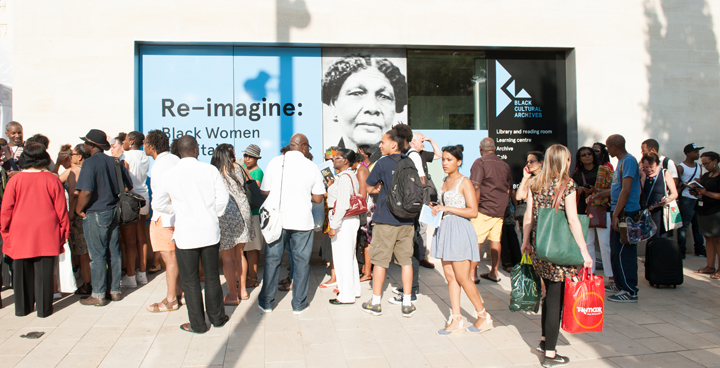Difference between revisions of "The importance of the archive"
| Line 6: | Line 6: | ||
For African diasporic communities, the act of archiving is not only part of artistic practice, but of negotiating identity and preserving unrecorded heritage. According to Jacques Derrida, the power in the archive lies in not only the housing of objects and documents of historical importance, implying a physical space, but also in their ''interpretation.''<sup>1</sup> | For African diasporic communities, the act of archiving is not only part of artistic practice, but of negotiating identity and preserving unrecorded heritage. According to Jacques Derrida, the power in the archive lies in not only the housing of objects and documents of historical importance, implying a physical space, but also in their ''interpretation.''<sup>1</sup> | ||
| − | A number of the crowdfunding campaigns undertaken by artists of African descent, such as [[http://crowdsociety.org/index.php/Crowdfunding_art_across_the_african_diaspora#Andrea_Chung|Andrea Chung]] and [[Crowdfunding_art_across_the_african_diaspora#Charlie_Phillips_.26_Photofusion|Charlie Phillips]], have incorporated both the act of archiving and the use | + | A number of the crowdfunding campaigns undertaken by artists of African descent, such as [[http://crowdsociety.org/index.php/Crowdfunding_art_across_the_african_diaspora#Andrea_Chung| Andrea Chung]] and [[Crowdfunding_art_across_the_african_diaspora#Charlie_Phillips_.26_Photofusion|Charlie Phillips]], have incorporated both the act of archiving and the use of archival material, usually photographic. In this way, the static nature of an archive is imbued with a dynamism that renders is a living, growing being rather than just a historical resource. |
Furthermore, the creation of an archive is often reliant on a source community, such as the [http://bcaheritage.org.uk/ Black Cultural Archive] in London, which finally opened to the public in 2014, thirty three years after it was founded. Housing papers and objects documenting African and African-Caribbean life in Britain, it is the only institution of its kind in the UK, and the opening attracted thousands of visitors. | Furthermore, the creation of an archive is often reliant on a source community, such as the [http://bcaheritage.org.uk/ Black Cultural Archive] in London, which finally opened to the public in 2014, thirty three years after it was founded. Housing papers and objects documenting African and African-Caribbean life in Britain, it is the only institution of its kind in the UK, and the opening attracted thousands of visitors. | ||
| Line 13: | Line 13: | ||
720x368-opening-of-BCA.jpg | 720x368-opening-of-BCA.jpg | ||
| + | The Seattle Museum of History and Industry recently acquired an extensive collection of vernacular photography of the city's African American community throughout the twentieth century. Due to the informal nature of many of the photographs in the archive, the subjects are unidentified. The museum, in partnership with a local radio station and the National Afro-American Museum and Cultural Center, is reaching out to the general public in hope of identifying some the individuals featured. | ||
| − | + | http://kuow.org/post/rare-photos-black-seattle-unearthed-help-id-them | |
| − | + | ||
<sup>1</sup> Derrida, J. 1995: ''Archive Fever.'' University of Chicago Press. | <sup>1</sup> Derrida, J. 1995: ''Archive Fever.'' University of Chicago Press. | ||
Revision as of 17:45, 7 May 2015
The archive has been the space of intervention from the beginning. And I suppose that will be the motif for the rest of the practice. But the archive also has an overarching historic importance, because it’s connected to this question of diasporic identity. One of the few spaces, reservoirs of memory for diasporic subjects IS the archive.
– John Akomfrah
For African diasporic communities, the act of archiving is not only part of artistic practice, but of negotiating identity and preserving unrecorded heritage. According to Jacques Derrida, the power in the archive lies in not only the housing of objects and documents of historical importance, implying a physical space, but also in their interpretation.1
A number of the crowdfunding campaigns undertaken by artists of African descent, such as [Andrea Chung] and Charlie Phillips, have incorporated both the act of archiving and the use of archival material, usually photographic. In this way, the static nature of an archive is imbued with a dynamism that renders is a living, growing being rather than just a historical resource.
Furthermore, the creation of an archive is often reliant on a source community, such as the Black Cultural Archive in London, which finally opened to the public in 2014, thirty three years after it was founded. Housing papers and objects documenting African and African-Caribbean life in Britain, it is the only institution of its kind in the UK, and the opening attracted thousands of visitors.
The Seattle Museum of History and Industry recently acquired an extensive collection of vernacular photography of the city's African American community throughout the twentieth century. Due to the informal nature of many of the photographs in the archive, the subjects are unidentified. The museum, in partnership with a local radio station and the National Afro-American Museum and Cultural Center, is reaching out to the general public in hope of identifying some the individuals featured.
http://kuow.org/post/rare-photos-black-seattle-unearthed-help-id-them
1 Derrida, J. 1995: Archive Fever. University of Chicago Press.
